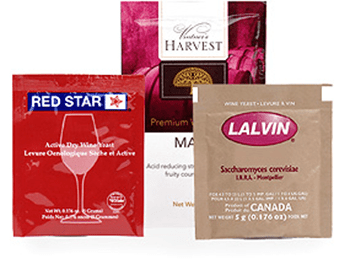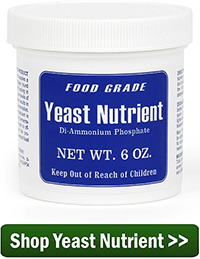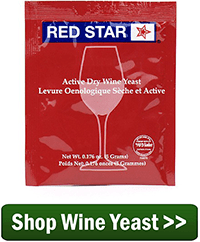 I need you to help me settle a bet with a friend who also makes wine. He says that wine yeast is no different than what you can get in the store to make bread with. His quote “yeast is yeast”. I say that it is different, although I can’t explain how. Please help settle this and let us know who has to pay up, plus if there is a difference between wine yeast and baking yeast can you explain it to me.
I need you to help me settle a bet with a friend who also makes wine. He says that wine yeast is no different than what you can get in the store to make bread with. His quote “yeast is yeast”. I say that it is different, although I can’t explain how. Please help settle this and let us know who has to pay up, plus if there is a difference between wine yeast and baking yeast can you explain it to me.
Thanks,
Jamie
———-
Hello Jamie,
I’m going to be brutally honest, here. I hope this doesn’t break-up a good friendship.
To say that yeast is yeast is like saying a dog is a dog. Over the centuries dogs have been bred for various, specific tasks: hunting, herding, personal protection, attacking, protecting herds, companionship, etc. The same can be said for yeast. They have been bred over the decades to perform specific tasks: rising bread, making alcohol, bio-degrading oils, pharmaceutical production, etc.
So to bring this analogy full circle, when you’re making wine with a baking yeast, you’re hunting grizzlies with a chihuahua. Sorry friend, but wine yeast and baking yeast are not the same. In fact, they are very different. I would never recommend making wine with bread or baking yeast.
Wine yeast in particular is bred to obtain higher alcohol levels than baking yeast. On average, bread yeast will get you 9 or 10%. Anything higher than that is possible, but the baking yeast will have to struggle considerably.
Wine yeast are bred to thrive very well with the set of nutrients fruits naturally provide. Baking yeast, on the other hand, prefers the balance of nutrients found in grains or bread doughs.
Wine yeast clears more quickly from the wine than baking yeast. Wine yeast is bred to clump together as the fermentation activity slows – a process known as flocculation. The clumping allows the wine yeast to drop out and settle to the bottom more quickly. Baking yeast does not clump or flocculate. Instead, it slowly settles to the bottle as a fine haze. This process can take weeks instead of days.
Wine yeast foams less than baking yeast. This is because wine yeast are bred to produce less surface tension in the liquid than baking yeast.
Wine yeast is also more tolerant to sulfites than baking yeast. The wine yeast has actually been acclimated to coexist with some residual sulfites such as Campden tablets in the wine. This means that wine yeast can ferment just fine with some sulfites in the wine must. Baking yeast is not as fortunate. Even small amounts of sulfites can stop a wine fermentation dead in its tracks.
Another issue is that bread yeast is only packaged under food-grade conditions. This is certainly suitable for baking. The yeast is only being utilized for a few hours, not days, so the perpetuation of any contaminating organisms do not have enough time to do any damage.
On the other hand, with wine yeast we are talking days if not weeks that the yeast is in play. This is plenty of time for stray organisms riding on the yeast to potentially breed into a full-fledged infestation spoiling the wine. For this reason, wine yeast is package under sterile conditions. This is far more stringent than food-grade packaging.
To sum all this up, you can certainly make wine with a baking yeast, but you will be sacrificing flavor and potentially alcohol. You are also increasing the likelihood of having a stuck fermentation. This is because of issues with nutrients and the use of sodium metabisulfite.
So, as I think you can see, wine yeast and baking yeast are not the same. In fact, there are many differences between the two. That combined with the fact that wine yeast is not all that expensive to buy, why wouldn’t you use it in your winemaking?
Happy Wine Making
Ed Kraus
—–
Ed Kraus is a 3rd generation home brewer/winemaker and has been an owner of E. C. Kraus since 1999. He has been helping individuals make better wine and beer for over 25 years.

Dear ED Kraus, I use to make red wine witout using yeast, shuger, etc. I leave the grape for 40 days in sealed tank equiped with airlock. After 40 days l mix it every 2 days for 12 days, after 12 days is ready to drink and after one year I have a very good wine according to my freinds.
As long as you keep giving it to your friends they will tell you that. People will say ANYTHING good to you as long as you give them free stuff. Don’t be offended, its human nature. Peace. Ps, I think your winemaking technic is special.
I made 50 gallons of blackberry wine a few years back, put it into Jacobs Creek red wine bottles it was really good 13% vol. had few friends around for dinner who we would consider wine snobs – were drinking away on the third glass a asked what did they think of the wine, said it was great, and you cant go wrong with Jacobs creek wine – jaw dropped on brother in law when I said was home made from blackberries, pushed the glass to one side and said he had enough anyway! wine snobs have their head up their own asses.
Hello sir I presently working on apple cider is it possible for you to clear few of my doubts,
During fermentation of sucrose into alcohol what cfu no. We need to mentain in our broth.
Even if your recipe calls for wine yeast, you can easily substitute bread yeast without having an adverse effect on the final product.
It seems ludicrous to use bread yeast to make wine when the different wine yeasts I have used are easily obtainable..
If you don’t want to use Wine Yeast, might as well just use the natural yeast that settles on the fruit while growing or that which is floating thru the air? Primary fermentation might take 2ce as long and no telling what the final flavor will be like.
Last year, just to try, I picked, pressed and fermented grapes using the Natural Yeast that was on the skins. I did add sugar and pectic enzyme and ended up with 1 small batch at 15% and a stronger small batch at 17%. Not as pleasant flavor as that made with Wine Yeast.
Hi all. I have made apple juice cider with bread yeast ( I had some spare as I also make my own bread) . Came our at about 6% which was what I was looking for. The resulting cider was good. Would not use it for wine making though.
I opened a bottle of pure Welches grape juice and left it out in a wide mouthed glass
Sitting near a bowl of all sorts of fruits including bananas, strawberries, lemons, oranges, Tomatoes, dried apricots. It sat there untouched with nothing added for
Perhaps 8-10 days but seemed to be gathering debris on top…it had a scent of
Fermentation. I tried it. IT WAS REMARKABLY GOOD. . .it had a sharp little alcoholic
Bite and was delicious. I added no sugar or anything. I thought it was the best wine
I had ever tasted… something I could actually enjoy. . .and I did.. (I don’t really drink
Or like regular wines.). I FELT THIS MUST BE CLOSER TO THE FIRST. WINES THAT
WEEE DEVELOPED WITHOUT ALL THE FUSSING . I’m going to try a larger batch
Using regular bakers yeast to shee how that developes. This is fun. . .no tannins, no
Bitterness … just real wife from real grape juice
Untouched w
With the virus and the greedy hoarders I can’t get yeast right now, at least not for bread, but Amazon has wine yeast. Never could get a definitive answer on the net, some say yeas you can make bread with wine yeast, some said no, some said it would have an ‘alcoholic’ bitter flavor . So I gave it a go. Wish I could post a pic , the soft rolls rose to perfection and are beautiful and as tasty as any others I’ve made.
Thanks for your report on using it for bread. I also found on the five-star yeast on amazon, but did not even notice it was “wine yeast”! I want to make foccacio flat bread and pizza dough. Have you, or anyone reading this given that a try?
I’m very Sharon, but I do not have any direct experience with this. Anyone else?
My wife has been using my old wine yeasts for bread for the last 6 months. It works just as good as standard bread yeasts. I did ask her to double up the dose due to the fact that aged packages of yeast have less viable cells than a fresh pack/brick of any yeast. It’s a great way to use it up rather than tossing it.
After decanting my wine (muscadine), I save the remaining wine and settled solids in a mason jar in the refrigerator. I mix a cup of this with a cup of flour (whole wheat) and 2 tablespoons of sugar and let ferment for a couple days with occasional stirring. I then add a teaspoon of salt and enough flour to bring to bread dough consistency, coat with olive oil and let rise for a couple hours. Makes a great sour dough for loaves or flat bread with interesting color and taste.
Sounds great as far a making wine with baker’s yeast but today I am on the other side of the coin. Due to the Covid-19 situation I can’t find brewer’s yeast at the supermarket so I went into my wine room and am thinking of using one of my Lalvin ECX-1118 or similar to bake bread. Any thoughts on that. Would I be making a “Cadilac of a bread” ? LOL
Hi guys, my husband did buy wine yeast by mistake. I want to make some breads with it. Do you have a recipe? Thanks!
Juliana,
Work up your bread recipe as usual if you already have one – things will be ok. You might want to rehydrate the wine yeast in a half cup of 100 degree water with a pinch or two of sugar for ten minutes or so just to give it a jump start.
Beyond that:
2c flour
1T sugar
1t salt
2T oil
rehydrated yeast
1 egg if you’re making dinner rolls (perhaps kick the oil down by a t)
A couple T of water or a bit more flour to yield a springy but sticky dough – this part I generally do by ‘feel’.
Get your COVID workout while kneading the dough.
Let it rise, form it up, let it rise again and bake as usual.
Very interesting
We grow a lot of fruit in our Orchard in the mountains. So its difficult to get wine yeast here, so I’m thinking of using no yeast in my apricot wine. I will try to make wine with sugar and water. Let’s see!
We grow a lot of fruit in our Orchard in the mountains. So its difficult to get wine yeast here, so I’m thinking of using no yeast in my apricot wine. I will try to make wine with sugar and water. Let’s see! I’m hoping it all goes well
I’ve been using wine lees to boost more limited use of bread yeast in breadmaking during lockdown. And I’ve recycled wine lees to make the next batch of wine. If yeast in the form of lees tastes good, these are good and alcohol preserves lees which have had the wine filtered out of them, when kept in the fridge. Apple cider which I’ve made with the wild apple yeast – and cascaded into the next batch of pressed juice has all been best tasting, but I do make some cider each year using wine yeast in case the wild yeast fermented cider doesn’t keep so well. But I’ve not had any problems and the wild yeast cider has tasted slightly better each year I’ve done this compared to the same juice fermented using wine yeast.
I’ve not tried using bread yeast for wine making as there’s never been a point, but if I didn’t have wine yeast but did have bread yeast I would certainly give it a try, though as with cascaded yeast, I don’t aim for over 12.5% ABV.
I agree with Ed Kraus about stuck fermentation after 6% of ABV is reached. Grain based mash is different than fruit mash. There is this moment when fermentation with fruits(fresh berries) make clay type fusion. In that moment something strange happening. Wine starts to make “contamination” type whitish skin on the surface (it is no problem if we filter all stuff with micro-filter and add fresh yeast after that to continue process till the end). I make my own yeast at start (long ago) and use it with success (I harvest it after fermentation) but not always, because of different ingredients in mash. P.S. I have a “savior” in my desk. It is Turbo yeast. I use it only in emergency situations. Something like that! Thank you, Ed!
Wine can be made with wine yeast only. Absolutely agree with Ed on this.
I bake great Foccacha bread using bread yeast, but to make wine I would never use bread yeast.
With this COVID all world in stagnation, maybe except those who created it, Bill Gates for example. They benefit from it. I don’t.
I lost my wine yeast supply and shipping abroad is frozen for suppliers. I live in the Caribbean and making wine with fruits, grapes are not growing here. At the very beginning of my home winery I was using wild yeast they are on the fruit skin.
But with my newest technique to use frozen fruits only it is not possible to use those wild yeast, they will be killed by freeze.
What would you recommend me, Ed?
Thank you
Yeast are not killed by freezing. For my winery I store my dry bulk yeast in a freezer that approaches -25F. Yeast cultures in facilities that make it for us (for baking, wine, brewing, pharmaceutical, etc) use cryopreservation which is a process where it is frozen in liquid nitrogen for long term storage and to maintain viability. Your challenge is to determine what kind of wild yeast was on those frozen fruits before they were processed – the good tasting ones or the nasty ones!